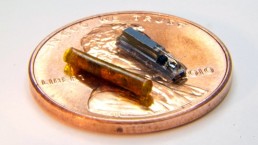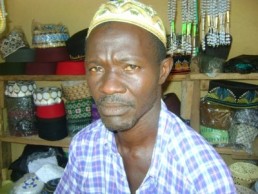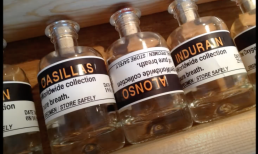Miniature oxygen generator implants to boost effectiveness of cancer treatments
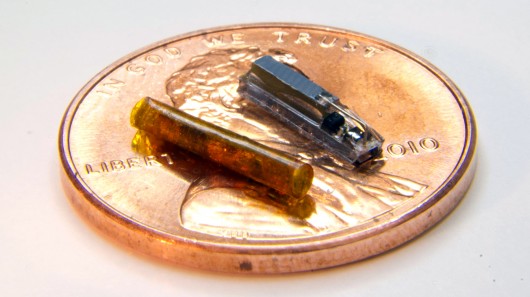
Some cancers, such as pancreatic and cervical cancers, are notoriously hypoxic, which means they contain low oxygen levels. Because radiation therapy needs oxygen to be effective, hypoxic areas of a tumor can be difficult to kill. To combat this, researchers at Purdue University have developed and tested a miniature electronic device that is designed to be implanted into solid tumors to generate oxygen and boost the effectiveness of radiation and chemotherapy treatments.
Once implanted into a tumor, the new "implantable micro oxygen generator" uses ultrasonic signals to generate a small voltage to separate oxygen and hydrogen from water in a chemical process called water electrolysis. The devides are just under one centimeter (0.39-in) long and are inserted into tumors with a hypodermic biopsy needle.
"We are putting these devices inside tumors and then exposing the tumors to ultrasound," said Babak Ziaie, a Purdue University professor of electrical and computer engineering and biomedical engineering. "The ultrasound energy powers the device, generating oxygen.
The devices, which were created at the Birck Nanotechnology Center in Purdue's Discovery Park, have been tested in pancreatic tumors implanted in mice. The tests showed the devices generated oxygen, which resulted in the tumors shrinking faster than tumors without the devices.
The Purdue researchers have filed a patent for the current design and are looking at the possibility of redesigning it to make it more practical for manufacturing and clinical trials.
The results of the team's research appear in a paper published online inTransactions on Biomedical Engineering.
About the Author
 Darren's love of technology started in primary school with a Nintendo Game & Watch Donkey Kong (still functioning) and a Commodore VIC 20 computer (not still functioning). In high school he upgraded to a 286 PC, and he's been following Moore's law ever since. This love of technology continued through a number of university courses and crappy jobs until 2008, when his interests found a home at Gizmag. All articles by Darren Quick
Darren's love of technology started in primary school with a Nintendo Game & Watch Donkey Kong (still functioning) and a Commodore VIC 20 computer (not still functioning). In high school he upgraded to a 286 PC, and he's been following Moore's law ever since. This love of technology continued through a number of university courses and crappy jobs until 2008, when his interests found a home at Gizmag. All articles by Darren QuickGoing on holiday to Norway soon?


DON'T LET THE USE OF OXYGEN CONFINE YOU!
Customers travel on land, air and sea using Portable Oxygen Concentrators .
The following International airlines approve the Inogen One, SeQual Eclipse and the Respironics EverGo: Air France, Air Canada, El Al Airlines, Alitalia, SAS Airlines, Lufthansa, Qantas, All Nipon Airways, ATA Airlines, Cathey Pacific, Icelandair, Norwegian, LTU International, Singapore Airlines, Swiss International, and Virgin Atlantic.
Many satisfied customers have used OxygenWorldwide for travelling to destinations such as Norway for their portable oxygen needs.
We have the equipment, we have the experience:
- International or Domestic Travel
- Back up service
- Air Travel
- Train Travel
- 24 hour service
OxygenWorldwide has been a leader in servicing the needs of medical oxygen travelers. We are experienced in serving your medical, home and airline oxygen needs while you are on the go!
What is fit to fly?
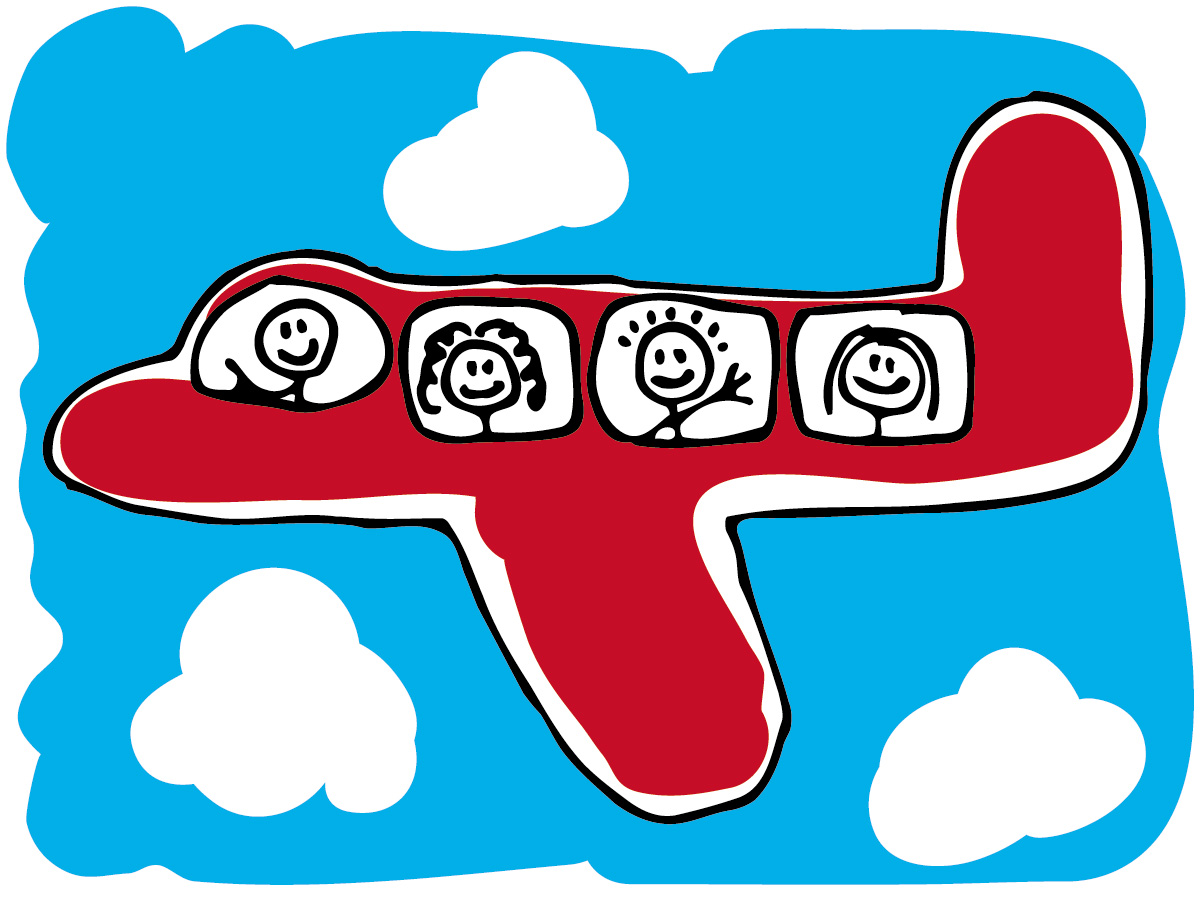
Most travellers with existing medical conditions are able to fly without difficulty. However, occasionally certain precautions need to be taken.
A fitness to fly form is required to be completed when:
- Fitness to travel is in doubt as a result of recent illness, hospitalisation, injury or surgery
- If you have an existing unstable medical condition
- You wish to use medical equipment or therapeutic oxygen on-board
Most medical cases are straightforward, but some require individual assessment. In certain cases, we may ask that you and your doctor complete a “Fitness to Fly' Form.
Carriage of a POC:
Passengers carrying a POC should obtain a Medical Equipment Approval & Baggage Waiver letter. This approval & waiver letter must be presented at the Bag Drop desk or at the boarding gate if travelling with no checked baggage.
Use of POC during Flight:
If you wish to use a POC during flight, for the use onboard you will be required to complete a 'Fit to Fly' form which will be sent to the passenger once the requirement has been notified. This completed “Fit to Fly' form must be returned between 14 up to 2 days prior to travel for validation. The validated “Fit to Fly form must be carried by the passenger on all flights and produced to our cabin crew on boarding the aircraft.
If the POC is to be used onboard it is the passenger’s responsibility to ensure that they have a sufficient number of fully charged batteries for the duration of the flight and any possible delays, as POC or batteries cannot be charged on board.
Individual airline carriers have their own regulations please check before booking departure for full details.
For further info and back up service please contact our team at info@oxygenworldwide.com or www.oxygenworldwide.com
For an example:
Please see below list of models approved for carriage on Ryanair flights:
Traveling with oxygen has become much easier with the development of portable oxygen concentrators

Traveling with oxygen has become much easier with the development of portable oxygen concentrators (POCs). These devices run on a battery pack, can be recharged, plugged into the wall or a cigarette lighter in a car, and can be taken on airplanes.
Commercial airlines must provide a cabin pressure altitude of no more than 8,000 feet of altitude. Your pulmonologist can determine if air travel is safe for you. Your pulmonologist may order an altitude simulation test to help determine your ability to fly safely at this cabin pressure.
If you are going to need oxygen in flight, you must make arrangements with the airline well ahead of time. You can use either the on-board oxygen supply.
The airline will require a physician's statement. The airlines generally have their own form for the doctor to complete.
Some tips for air travel with POCs:
- Start making arrangements with the airline well ahead of time to find out which POC is allowed. Many airlines list accepted manufacturers and brands on their websites.
- Allow plenty of extra time for check-in.
- Carry several extra battery packs. FAA regulations require enough battery time to cover 150 percent of the flight time.
- POCs and battery packs can be rented for travel, along with your POC.
- Carry an extra three-way plug for recharging your POC in the airport. People often need to recharge their electronic equipment in the airport during layovers, and this will help assure that you will be able to recharge yours.
- POCs are exempt from the carry-on count.
- Carry a prescription for oxygen, signed by your doctor.
For more information about POCs and air travel, go to www.oxygenworldwide.com
Last minute portable medical oxygen
Last Minute Europe's leading independent portable and medical oxygen company
Welcome to OxygenWorldwide - the world's leading specialist provider of medical and portable oxygen solutions. We fully understand the oxygen world can be a minefield, and can cause confusion. There is always a fully trained advisor available 24/7 if you have any queries or questions; just contact our team on info@oxgenworldwide.com
Recognised globally as a world-leading company in portable concentrators, we offer nothing less than professionalism at the highest standard. Open 24 hours a day, seven days a week, so we are always available to help you with any questions or queries you may have.
Kabba is taking out another loan on Kiva
Kabba is taking out another loan on Kiva - OxygenWorldwide help third world people to grow their own businesses.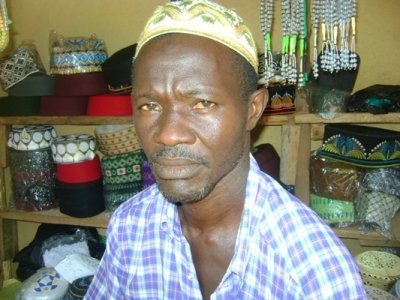 This is an update on ourr loan to Kabba in Sierra Leone. We wanted to let you know that Kabba has another loan posted on Kiva! Here's the description of their new loan: This is 52-year-old Kabba. He is married, and has four children aged 23, 20, 16 and 14. He has one additional dependent, who lives with him and his wife. In 1997, Kabba established his muslim caps and beads business. He began his business to enable him to solve his domestic problem. His business is located in the city center and his main customers are Muslim men and women. Working 7 days a week and 10 hours a day, he earns about Le 650,000 every month from this business. He would like a loan in the amount of Le 4,000,000. Kabba has already received and successfully repaid three loans, and now requires a new loan in order to buy dozens of Muslims caps (Le 2,500,000) and dozens of Muslims beads (Le 1,500,000). He hopes that this loan shall increase his stock level and hence his additional income level. In the future, Kabba plans to complete his construction of his house, to educate his children and to rent a shop. He thanks you for your support. You can see Kabba's new loan by visiting http://www.kiva.org/lend/593927?_te=rlnol. The Association for Rural Development (ARD) is one of the leading microfinance institutions in Sierra Leone. Established in 1989, ARD has offered individual and group loans to support small-scale businesses across the country for two decades. You can learn more about ARD on its partner profile page, support the organization and its staff by joining the ARD lending team, or lend to another one of its borrowers currently raising funds on Kiva. Additional notes from Kiva: 1. This update was posted from Sierra Leone by Kiva's Field Partner, Association for Rural Development (ARD). If you appreciate this update, please consider supporting another entrepreneur listed by this Field Partner. 2. If this journal entry is in a foreign language, you can use an online translator such as Google Translator 3. Also, you can recommend or comment on this journal. 4. You can browse and search through all of the updates to loans in your portfolio on the Updates Tab. 5. And finally, if you do not wish to receive these emails, you can disable them in your account email preferences. Thanks for lending to the world's working poor on Kiva! Best Wishes, The Kiva Team |
|||
|
|||
Top 10 European travel destinations for 2013
Porto & Douro Valley
The Yeatman is Porto’s finest hotel, and its Michelin-starred restaurant is well worth a visit even if you don’t stay the night.
Rooftops of Porto and the Douro River. Photo by Dmitry Shakin / Getty Images.
Budapest, Hungary
Szimpla Kert is the granddaddy of the garden bars and one of the best, now winterized to be open year-round.
The Széchenyi Baths on a summer day in Budapest, Hungary. Photo by Ellen Rooney / Getty Images.
Northern Iceland
Fancy a peek at a puffin? On the island of Grimsey, Iceland’s only true piece of the Artctic Circle, birds outnumber people 1000 to one. Divers can swim with seabirds, watching guillemots hunting for food deep in the crystal waters.
Fire and Ice – Riders on the frozen Myvatn Lake. Photo by Reinhard Pantke / Getty Images.
Cinque Terre, Italy
The best way to get around the Cinque Terre is with the Cinque Terre card available at all of the local train stations, which gives you unlimited use of the walking paths, electric village buses, the elevator in Riomaggiore and cultural exhibitions (one/two days €5/9).
Colourful Riomaggiore, Cinque Terre. Photo by Sergio Del Rosso / Getty Images.
Moravia, Czech Republic
To pedal your way through Moravian wine country, follow the Mikulov Wine Trail. The Mikulov tourist office (www.mikulov.cz/tourism) can help steer you to a one-day ride that takes in the nearby chateaux at Valtice and Lednice, stopping at small local vineyards along the way.
Elderflower wine, Mikulov, Moravia, Czech Republic. Photo by Paul Harris / Getty Images.
Bern, Switzerland
Get a taste of Bern’s locavore leanings at the popular Lötschberg AOC (www.loetschberg-aoc.ch), with an all-Swiss wine and beer list, local cheese specialities and seasonal produce.
Bern’s Old Town and the Aare River. Izzet Keribar / Getty Images.
Marseille, France
For a true bouillabaisse experience, head to Le Rhul for a classic approach or L’Epuisette for a swank Michelin-starred experience; reserve in advance for both.
Marseille’s Vieux Port. Photo by Alexandre Fundone / Getty Images.
Croatia
To experience Zagreb like a local, don’t miss Saturday morning špica, the coffee-drinking and people watching ritual that is the peak of the weekly social calendar.
Plitvice Lakes National Park. Photo by Kelly Cheng / Getty Images.
Northern Ireland
In October, Derry/Londonderry dusts off the skeletons and puts on the spooky makeup for the annual Halloween Carnival, Ireland’s biggest street party.
Dawn on the Giant’s Causeway. Photo by Riccardo Spila / Getty Images.
Copenhagen, Denmark
The strikingly modern Louisiana Museum of Modern Art in nearby Humelbæk is worth the side trip even if you’re not a passionate fan of modern art. Inside find Picasso, Giacometti and an entire wing for kids; outside find Henry Moore, Alexander Calder and artfully framed views across the water to Sweden.
City bikers in Copenhagen. Photo by Dag Sundberg / Getty Images.
Read more: http://www.lonelyplanet.com/europe/travel-tips-and-articles/77757#ixzz2bhGWEMXI
Preparation is the key and will make your travels more enjoyable

For those with diseases such as chronic obstructive pulmonary disease, emphysema or chronic bronchitis, supplemental medical oxygen is a necessity. If you have ever tried to travel with supplemental oxygen, you know how difficult this can be. Being prepared, and knowing how to travel safely with oxygen and where to obtain oxygen at your final destination is vital.
Always check with your doctor and your oxygen company before traveling.
Safety is a very important issue when traveling by car, as an oxygen tank can become a dangerous projectile in an accident. It is crucial to secure the unit. Your oxygen company can provide you with information about safe ways to store and protect your particular oxygen unit in a vehicle.
Portable oxygen concentrators — which form oxygen by extracting and separating it from the surrounding air, and deliver it through a nasal cannula — may be stored in any position, but they should be padded to protect them from impact.
Small cylinder tanks holding compressed oxygen in gas form can also be stowed in any position, but the valve on top and the liter flow knob must be protected from collision through use of a seatbelt, webbing or other such device.
All unit types should be protected from heat, so they should not be stored in a car’s trunk, where extreme heat build-up can occur. In case of a fire, additional oxygen causes a fire to burn more rapidly, so always keep a car window open at least a crack to prevent the accumulation of more than the normal amount of oxygen. When refilling oxygen tanks at an outdoor facility, always remove the tanks from your car and place them in a well-ventilated area.
Travel by airplane also takes a good amount of research and preparation. No airline will allow you to bring aboard your own oxygen cylinder, but many airlines have medical oxygen cylinders available for a fee for use on their planes, such as Alaska Airlines, British Airways, Continental, Delta and Japan Airlines. The oxygen containers used on airplanes vary from airline to airline.
You must make arrangements to provide your own oxygen to and from the airplane. It is helpful to have someone take you to the airport and allow him or her to take your tank home.
Many airlines, such as Alaska Airlines, Delta, Frontier and Southwest, now allow travelers to bring aboard their own portable oxygen concentrators, but the airlines permit only the brands Inogen One or AirSep LifeStyle.
You must have enough fully charged batteries to last the entire flight and to allow for possible delays, as electricity will not be provided on the airplane. The way in which extra batteries must be stored varies from airline to airline. Contact your airline to obtain their regulations for battery storage.
You will also need to contact your airline to learn their requirements for advance notification of your need for medical oxygen. Many airlines will need a letter from your physician in advance of the flight, so they can contact him or her to verify liter flow. The letter should have a date of no more than one year prior to the flight (some airlines require a letter dated no more than 10 days prior to the flight), stating the amount of oxygen needed and the flow rate, adjusted to cabin pressure.
It is important to make advance arrangements for the delivery of oxygen to the airport of your destination. Almost all airlines require a 48-hour advance notice for domestic flights, and airlines can require up to 72 hours advance notice for international travel.
Many cruise lines allow you to bring your own oxygen, and they allow all types. Some will accept deliveries from medical-supply companies, while others only allow certain companies to deliver. You will need to contact the customer service department of the cruise line for the regulations on each ship.
When traveling by train, contact the customer service department to obtain regulations about traveling with medical oxygen.
In Europe, the rules and regulations for oxygen use on Eurail vary from country to country. There is no one place to find the information for a trip that takes you from country to country. Your best bet is to contact the customer service department of the railroad in each country you will be traveling through. You can find this information on the Eurail Website.
Being well prepared will make your travels much more enjoyable.
Happy travels!
OxygenWorldwide Reveals Challenging Design of Medical Oxygen Vest
OxygenWorldwide.com has revealed its design for a Medical Oxygen Vest ( M.O.V.) for those medical oxygen users who want or need to be exeptional mobile like e.g. children or golfplayers.

OxygenWorldwide, market leader in the medical oxygen travel branch for 20 years challenges with its Medical Oxygen Vest (M.O.V.) a fast growing but rather conservative market when it comes to the design of portable oxygen equipment.
It shows that, in the past few years a unilateral design/development of portable oxygen concentrators (POC’s) has taken place. The medical oxygen equipment industry has put it’s emphasis mainly on making the units smaller and lighter, says Rutger Berntsen, founder and marketing director of OxygenWorldwide . OxygenWorldwide is worlds largest company that arranges medical oxygen for travellers in more than 100 countries and thousands of holiday destinations. Over the past 5-6 years the market shifted from renting more traditional stationary oxygen equipment like cylinders, concentrators or liquid oxygen with a stroller to portable devices. Having clients travelling with these POC’s every day Berntsen and his colleagues were confronted with the various problems that arise using this particular equipment. Searching for a solution was a natural progression.
The Medical Oxygen Vest is a body warmer type of vest that contains the necessary equipment to provide medical oxygen to the wearer. The vest would be ideal for oxygen users who require a constant supply of medical oxygen and the life line of being able to be mobile and freely move around without the constraints of a more conventional oxygen device. The M.O.V is designed for e.g. young children or active sport users to give the ability to move around more freely such as going to play a game of golf or running around in the playground.
A portable oxygen concentrator (POC) is normally carried around by means of a shoulder strap. This is not convenient when one has to make movements beyond normal walking. The main advantage of the M.O.V. is that the weight of the equipment in the vest is equally divided over two sides located under the arm pits. The fact that the equipment is ‘concealed’ inside the vest could take away the burden of having to carry around a medical device, which to many medical oxygen users indicates the appearance that you are in fact a ‘patient’. Flexible solar panels are placed on the chest and back of the vest to provide (at this stage) power to the display panel. To make the system fully operational the batteries should (at this stage) be charged by plugging into a AC outlet. POC developers interested in learning more about de M.O.V. should contact Rutger Berntsen at + 34 96.688.28.73 Or view the video online at (www.oxygenworldwide.com/mov-design).
About OxygenWorldwide.
OxygenWorldwide is worldleader when it comes to arranging medical oxygen for travellers. (www.oxygenworldwide.com)
OxygenWorldwide is based in Spain but operates in more than 100 countries and thousands of holiday destinations. All staff members speak a minimum of 5 languages and provide a 24/7 telephone service.
Rutger Berntsen, Marketing director.
OxygenWorldwide s.l.
rutgerbernsten (at) oxygenworldwide (dot) com

